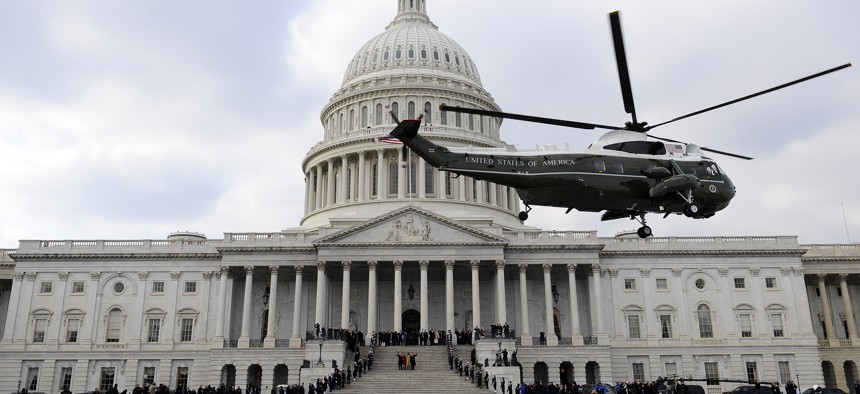
Former President George W. Bush departs on a Marine helicopter from the U.S. Capitol as President Barack Obama, first lady Michelle Obama, Vice President Joe Biden and his wife wave goodbye. AP Photo/Tannen Maury
Donald Trump Won’t Attend Biden’s Inauguration. So How Will He Leave Washington?
The timing of the departure has numerous logistical implications, including the plane’s call sign.
There’s been wide speculation about how Donald Trump might use his final day in office — perhaps by holding a rally in Florida, announcing a re-election bid or flying to his golf club in Scotland. The outgoing president used his final tweet, as it turned out, to announce that he will not attend his successor’s inauguration on Jan. 20. But exactly when and how Trump might leave town is still unknown.
The timing of his departure will determine lots of important logistical factors. If Trump leaves before Joe Biden is sworn in, he’d have the typical security and staff entourage that accompanies any sitting president when traveling, Including a military aide who could transmit nuclear weapons codes in the event of an attack.
If Trump departs in an Air Force jet, as have all modern presidents, it would likely be a customized Boeing 747 or smaller Boeing 757. The service would have a back-up plane at the ready should a maintenance issue arise with the primary jet. If his plane takes off before Biden is sworn in, it would use the callsign Air Force One. Should Biden be sworn in while Trump is in the air, that plane would change callsigns mid-flight. That happened in 1974 when then-President Richard Nixon left Washington aboard an Air Force Boeing 707, which changed call signs enroute to California when Gerald Ford took the oath of office. Trump’s plane would likely switch its callsign to SAM45, standing for “Special Airlift Mission” and “45th president.”
In the unlikely event that Trump decides to leave Washington in his personal Boeing 757, that plane could not use the Air Force One callsign, since it’s not a military jet. If he is still president at takeoff, the 757 would use the call sign Executive One, used when the president is flying aboard a civilian aircraft. That plane would change to a civilian call sign midflight if Biden is sworn in while Trump is in the air. As President-elect, Trump’s personal 757 used the call sign Tyson 1. (By the way, the Air Current’s Jon Ostrower reports that Trump’s 757 is being refurbished in advance of the president’s return to civilian life.)
In modern times, the outgoing president attends his successor’s inauguration, then gets a ride aboard the plane he used as Air Force One to a destination of his choosing. Before air travel became the norm, some former presidents left by train, as Harry Truman did after President Eisenhower’s inauguration in 1953.
In recent decades, the outgoing president and first lady walk down the back steps of the Capitol to an awaiting helicopter, which then makes the short five-minute flight over to Joint Base Andrews in nearby Maryland. Upon arriving at Andrews, the former president and first lady are usually greeted by a military honor guard, former staffers, friends and other well wishers.
President Barack Obama and his wife Michelle walked down the eastern steps of the Capitol, exchanged pleasantries with President Trump and his wife Melania, and boarded a military helicopter. The SH-3D Sea King, one of the helicopters used as Marine One, flew to Andrews, where the Obamas boarded one of the Boeing 747s he used as Air Force One. (Much the same happened when George W. Bush departed in 2009.) The Obamas’ plane used the call sign SAM44 for its flight to California.
Jimmy Carter took a motorcade to Andrews for his flight home to Georgia. After the 2001 inauguration, the Clintons traveled in a motorcade to Andrews for their short flight to John F. Kennedy Airport in New York because bad weather prevented the quick helicopter flight from the Capitol.




